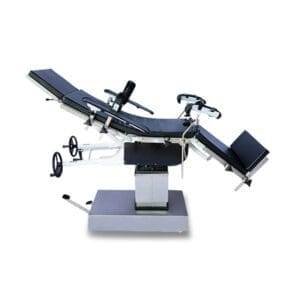Indirizzo
304 Il cardinale nord S.
Dorchester Center, MA 02124
Ore di lavoro
Dal lunedì al venerdì: 7:00 - 19:00
Fine settimana: 10:00 - 17:00
Operating a Manual Operating Table (OT Table) in a healthcare setting demands precision, skill, and utmost attention to safety. In this extensive guide, we will explore the ins and outs of safely operating a manual OT table. Whether you are a surgeon, a nurse, or a medical professional, understanding the correct procedures is crucial for the well-being of both the patient and the surgical team.
An OT table is more than just a platform; it’s a crucial instrument in the theater of surgery. The safety and well-being of the patient during a surgical procedure heavily depend on the proper operation of the OT table. Whether you are a seasoned surgeon or an aspiring medical professional, this guide will equip you with the knowledge and skills needed to safely operate a manual OT table.
 Surgery is a delicate dance of science and art. One small error can have serious consequences. Operating an OT table safely is paramount to ensure the patient’s comfort and stability during the procedure and to enable the surgeon to perform with precision.
Surgery is a delicate dance of science and art. One small error can have serious consequences. Operating an OT table safely is paramount to ensure the patient’s comfort and stability during the procedure and to enable the surgeon to perform with precision.
Before a surgical procedure begins, a series of pre-operative checks must be conducted on the manual OT table. These checks include examining the table’s mechanical components, ensuring that all locking mechanisms are functional, and verifying that the table’s height and tilt adjustments are in proper working order.
Creating an environment conducive to safe OT table operation is crucial. This includes ensuring proper lighting, maintaining a sterile field, and having all necessary surgical instruments and equipment readily available.
The safe operation of an OT table begins with the proper transfer of the patient onto the table. This step involves careful coordination among the surgical team to ensure the patient is transferred without injury or discomfort.
Once the patient is on the table, it must be positioned correctly. This includes adjusting the height, tilt, and lateral tilt to align the patient optimally for the surgical procedure. Additionally, a securement system must be used to prevent unintentional movement during surgery.
-300x300.jpg) Adjusting Height and Tilt
Adjusting Height and TiltThe manual OT table’s adjustable height and tilt functions allow for precise positioning. Knowing when and how to adjust these parameters is critical for maintaining patient comfort and ensuring the surgeon’s access to the surgical site.
Stability is paramount during surgery. The OT table must be locked securely in place to prevent any unintended movement or shifting during the procedure. Surgeons and surgical staff should double-check the stability before and during surgery.
Operating a manual OT table requires finesse and precision. Smooth, controlled movements are essential to avoid sudden jolts or adjustments that could disrupt the surgical field.
After the surgical procedure is completed, there are specific steps to follow for safely removing the patient from the OT table. This includes undoing securement systems and ensuring the patient is transferred without injury. Additionally, the OT table should be returned to its original position and locked securely for cleaning and maintenance.
A1: Manual OT tables come in various sizes and weight capacities. Some are designed to accommodate bariatric patients, but it’s essential to select the appropriate table based on patient size and surgical requirements.
A2: If the OT table malfunctions during surgery, inform the surgical team immediately. Depending on the situation, the patient may need to be transferred to another table, or the issue may be resolved if it can be safely addressed.
A3: Regular maintenance is essential for OT tables. The frequency depends on the manufacturer’s recommendations and the intensity of use. Typically, thorough maintenance should be performed at least annually.
Safely operating a manual OT table is a critical skill for any healthcare professional involved in surgical procedures. Proper preparation, patient positioning, and meticulous attention to detail during operation are paramount for the safety and success of surgeries. By following the guidelines outlined in this comprehensive guide, healthcare teams can ensure that the patient’s well-being remains the top priority throughout the surgical journey.
